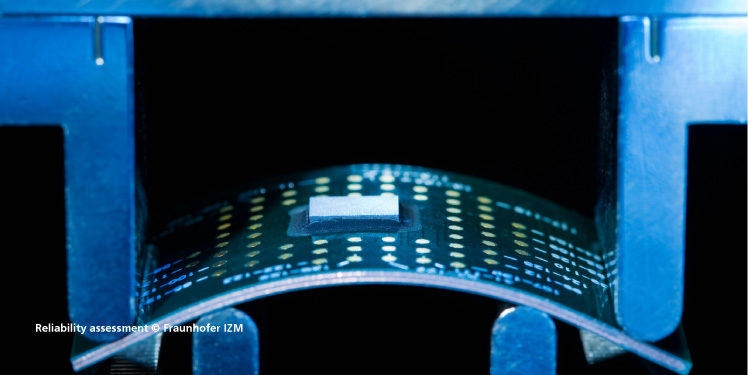Driven by the digital and ecological transition, the term “eco-reliability” has gained increased popularity within the last years. The main objective of this article is to present this new approach from its complementary perspectives “ecology and reliability” and to highlight the importance of different interdependencies as a process of multi-criteria decision making. Fraunhofer IZM benefits from more than twenty-five years of experience in environmental assessment and eco-design as well as the Institute’s expertise in reliability testing and lifetime optimization. What the researchers have learned from experience is that good product and system design needs to consider both aspects as soon as possible in the design process to become a potentially paramount factor in the eventual product concept and marketing strategy.
Ecological assessment
The environmental impact of a product depends on its entire life-cycle, covering design, production, use and the end-of-life phase. For this reason, life-cycle oriented environmental assessments are the prerequisite to measure and improve the overall environmental performance of products. However, the assessment comes with different challenges at each stage.
As an example, manufacturing depends on complex and globally scattered supply chains with limited traceability and data availability. The usage behaviour depends on aspects such as the usage intensity or the maintenance concept, which can lead to different life-cycle scenarios. The end-of-life phase and the intended end-of-life concepts are also not set in stone: A product’s life ends with its eventual disposal, but repair, reuse, or the refurbishment / remanufacturing of components can extend its servicable life.
In most cases, a longer-lived product is ecologically the best strategy. However, in some cases, there is a trade-off between environmental impact and life expectancy. Both aspects can and should be considered in combination during the product’s original design and conception phase.
Assessing Reliability
The life of a product extends from its manufacturing and its time in active use to its eventual disposal. As such, the product’s life expectancy is influenced by factors of technical reliability. This term describes the ability of a product to serve its function over a given period of time under a given set of conditions.
Quantifying technical reliability in this sense is therefore a complex undertaking, leading to a probabilistic figure that depends on many boundary conditions regarding load types, loading times, and load strengths. Despite its complexity, a careful assessment of this aspect is essential when developing new products and is often facilitated by drawing on experience and long-term data from earlier product generations.
A product is considered reliable when it performs the required functions for a specified period of time while exposed to stress. The number of failed products per million products in the field (ppm) over the entire service life is often used as an indicator of reliability. 0 ppm failures would be the desired goal for manufacturers and users alike. To reduce their environmental impact without compromising on reliability, designers need to have a thorough understanding of what causes products to failure.
The causes for failing electronic products can be divided into “over-stress” and “wear-out”. “Over-stress” failures occur when a service load exceeds the strength of a product (using a physical failure model). Some may cause only minor changes or damage to the product that do not result in immediate failure, but they will “wear out” the product over time. Most wear-out failures are due to the need to use materials with different CTE (coefficient of thermal expansion). Poor thermal design can also lead to typical over-stress failures. A dominance of wear-out over overvoltage fault indicates statistically the end-of-life. For the practical user experience of a single product also the “over-stress” can define the perceived lifetime. Both highlighted aspects (wear-out and over-stress faults) depend on the design of the product.
The Eco-Reliability Approach
The eco-reliability approach combines the ecological and reliability assessments described above into one single strategy. There are three main objectives for eco-reliability:
The first objective is to minimize the impact on nature. This includes the greatest possible reduction in air and water emissions, waste, and the use of toxic substances. Life-cycle assessments can help identify the environmental hotspots throughout a product’s lifetime and can prevent unexpected events in this context.
The second objective is to maximise a product’s durability, meaning its ability to function as required, under defined conditions of use, maintenance and repair, until a limiting state is reached. Enhanced product reliability and design for repair and recycling are useful strategies for life-cycle value retention.
The third objective is increasing the overall value of products or services: Providing more benefits for consumers in terms of product functionality, flexibility, and modularity while keeping the costs reasonable.
Fraunhofer IZM is actively working to introduce the thinking behind application-specific reliability assurance processes and its methods in the development and production of electronic systems. As part of this effort, the Institute is hosting an online workshop on the ‘Reliability of Electronics Systems’, which will explore relevant definitions and terminology, system analysis methods, and realistic stress tests. If you are interesting in attending virtually, you can do so by registering here.
IT CAN BE ALSO INTERESTING FOR YOU:
- How Wearables Will Affect Protection, Fashion, and Communication
- Modular Electronics – A Sustainable Solution for the Smartphone Era?
- Three Disruptive Technologies in Microelectronics

